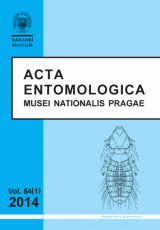Chewing lice (Phthiraptera: Amblycera et Ischnocera) from wrens (Passeriformes: Troglodytidae), with description of a new species of Myrsidea
Sychra Oldřich, Kounek Filip, Papoušek Ivo, Čapek Miroslav, Cárdenas-Callirgos Jorge Manuel, Franco Sebastian, Literák Ivan
Acta Entomologica Musei Nationalis Pragae 54(1): 1-27, 2014
Views: 1242
Abstract: A total of 114 individuals of 14 wren species (Aves: Passeriformes:
Troglodytidae) were examined. Nineteen birds (17 %) of six species were
parasitised with 292 chewing lice (mean intensity = 15.4 lice per bird)
belonging to three genera ? Brueelia Kéler, 1936, Penenirmus Clay &
Meinertzhagen, 1938 (Ischnocera: Philopteridae) and Myrsidea Waterston, 1915
(Amblycera: Menoponidae). Data on the occurrence of chewing lice on wrens,
including geographical distributions and some parasitological parameters ? such
as prevalence and mean intensity ? are updated and discussed. A description and
illustrations are given for Myrsidea fasciata sp. nov. from Campylorhynchus
fasciatus (Swainson, 1837) from Costa Rica. Penenirmus albiventris (Scopoli,
1763) is redescribed from Troglodytes troglodytes (Linnaeus, 1758) (from the
Czech Republic and Slovakia) and from T. aedon Vieillot, 1809 (from Peru).
Intraspecific morphological variation of P. albiventris is discussed, and
detailed figures are given. A portion of the mitochondrial cytochrome oxidase I
(COI) gene was sequenced from some species of Myrsidea and Penenirmus in order
to assess their relative genetic divergence. An updated list of all species of
lice recorded from wrens, including their geographic distribution, and a
host-louse list are also given.
Key words: Amblycera, Ischnocera, chewing lice, bird parasites, prevalence, mean intensity, geographic distribution, mitochondrial COI, phylogeny, taxonomy, new species, Troglodytes, wrens, Neotropical Region, Palaearctic Region
Papers
Chewing lice (Phthiraptera: Amblycera et Ischnocera) from wrens (Passeriformes: Troglodytidae), with description of a new species of MyrsideaA new species of Eremiothrips from Iran (Thysanoptera: Thripidae)Preimaginal stages and biology of Bactericera lyrata (Hemiptera: Psylloidea: Triozidae)Notes on the tribe Tongini, with description of a new species of the genus Orthophana from northern Vietnam (Hemiptera: Fulgoroidea: Nogodinidae)A new species of Cofana associated with grasses from India (Hemiptera: Cicadellidae: Cicadellinae)Taxonomic revision of the Neotropical genus Oiovelia (Hemiptera: Heteroptera: Veliidae)Revision of the genus Tachytatus (Heteroptera: Lygaeoidea: Rhyparochromidae)Afromenotes hirsuta, a new genus and species of Eumenotini from the Democratic Republic of the Congo (Hemiptera: Heteroptera: Dinidoridae)A revision of the genus Amblycara (Hemiptera: Heteroptera: Pentatomidae)Taxonomy and biology of the bromeliad-inhabiting genus Lachnodacnum (Coleoptera: Hydrophilidae: Sphaeridiinae)New species and subspecies of Octavius from South Africa, with a key and additional distribution records (Coleoptera: Staphylinidae: Euaesthetinae)Batrisceniola fengtingae sp. nov., the first record of the genus in China (Coleoptera: Staphylinidae: Pselaphinae)A new Callosides species from Ecuador with uniquely built membranous mandibles (Coleoptera: Hybosoridae: Anaidinae)New data about 'nalassoid' genera from south-eastern Anatolia with description of a new species of Zophohelops (Coleoptera: Tenebrionidae)A new species of the genus Callomecyna from Taiwan (Coleoptera: Cerambycidae)Review of Imatidiini genera (Coleoptera: Chrysomelidae: Cassidinae)Taxonomy of the Cape Verde endemic weevil genus Dinas (Coleoptera: Curculionidae: Entiminae). Part I: Description of a new subgenus, and two new species from S?o Nicolau IslandBiology and morphology of immature stages of Coniocleonus nigrosuturatus (Coleoptera: Curculionidae: Lixinae)Two new species of Austrolimnophila from the Mediterranean (Diptera: Limoniidae)Cladistic analysis of Rheochlus and related genera, with description of a new species (Diptera: Chironomidae: Podonominae)A new species of Feuerborniella (Diptera: Psychodidae) from the paramo of ColombiaThe identity and family affiliation of Scelomyza hirticornis (Diptera: Opomyzidae, Anthomyzidae), with a new checklist of Afrotropical AnthomyzidaeCatalogue of the type specimens deposited in the Department of Entomology, National Museum, Prague, Czech Republic. Polyneoptera 